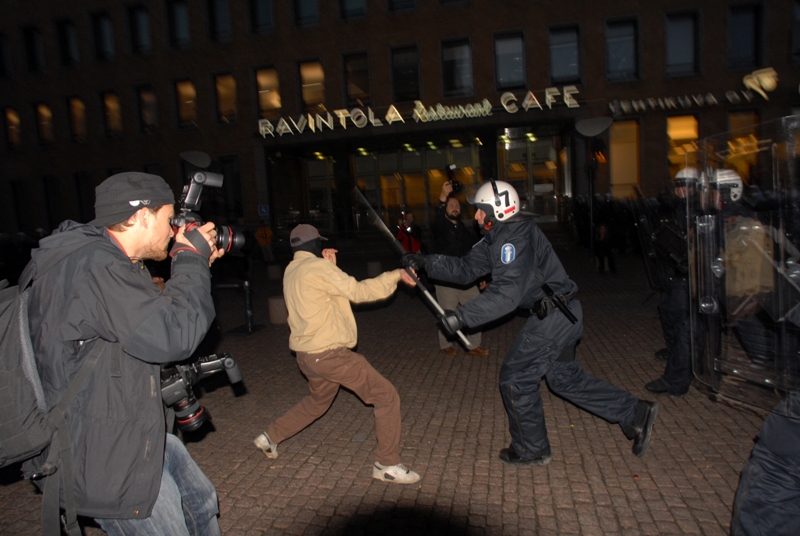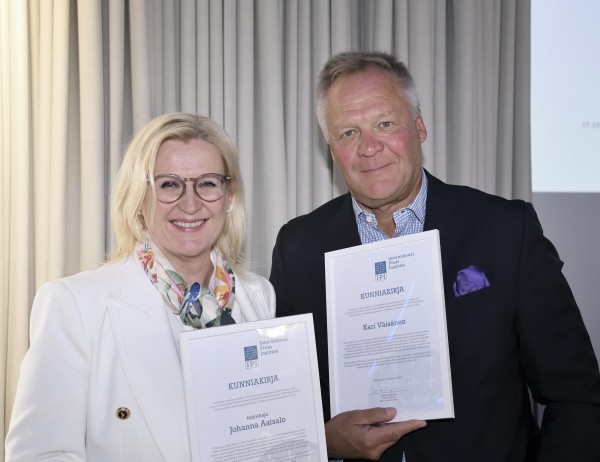The International Press Institute (IPI) today expressed disappointment in a European Court of Human Rights’ decision that a Finnish journalist’s arrest and conviction for ignoring police commands during a violent protest did not violate his right to free expression.
A divided panel on Tuesday ruled that the interference with weekly Suomen Kuvalehti photographer Markus Pentikäinen’s rights under Article 10 of the European Convention on Human Rights was proportionate and “necessary in a democratic society”.
Pentikäinen was convicted for refusing to obey orders to leave when the demonstration he was covering in 2006 in Helsinki’s Kiasma Square turned violent.
Citing public order, five members of a seven-judge panel in Strasbourg joined in a written opinion stating: “the fact that the applicant was a journalist did not give him a greater right to stay at the scene than the other people.”
The two other judges, however, questioned that reasoning.
“It has not been substantiated why it was necessary in a democratic society to equate a professional journalist, operating within recognised professional limits in covering the demonstration, with any of the people taking part in the demonstration and to impose drastic criminal restraints on him,” they said in a written dissent.
Although Pentikäinen’s conviction carried no sentence and will not appear on his criminal record, he told IPI that he expected to appeal the decision to the court’s Grand Chamber.
“It’s absolutely clear that this court ruling will strongly affect press freedom, especially journalists covering the operations and procedures of police and similar authorities in Finland, and in other European countries,” he said. “If a working journalist always has to be afraid of getting arrested and facing criminal charges in long court processes, it will have a great impact on the decisions we have to make in the field, such as: ‘To stay or not to stay?’ ”
IPI’s Finnish National Committee said today in a statement that it considered the ruling “baffling from the point of view of freedom of expression”. Noting that Pentikäinen’s arrest prevented him from reporting on the alleged use of excessive force against demonstrators, the Committee criticised police for ignoring “the fact that there were people [present] with differing status as to the freedom of speech”.
The Committee explained: “Photographer Pentikäinen was identifiable as a representative of the press. Legitimate demands of real time communication collided with the demands of the police. People have the right to know about the actions of authorities against citizens, and the press has the responsibility to report it. In the worst case, the ECHR’s ruling may severely restrict the freedom of the media to report on demonstrations.”
Pentikäinen was arrested as he was covering police efforts to clear a demonstration against the Asia-Europe Meeting (ASEM) on the evening of Sept. 9, 2006. Anarchist groups had organised opposition to the meeting under the slogan “Smash ASEM”.
After some demonstrators present threw bottles, stones and jars filled with paint, police sealed the square and cleared the scene of all but approximately 20 protestors. When police announced that anyone remaining would be arrested, Pentikäinen contacted his editor, who advised him to continue covering the protests. The journalist witnessed scenes of alleged police brutality as the square was cleared, but when he tried to leave, police arrested him and held him in custody for nearly 18 hours.
Finnish prosecutors accused him of failing to assert that he was a journalist when he was taken to a police station following his initial arrest and they said that he was released as soon as police determined his status. Prosecutors also argued that Pentikäinen should have been content to cover the demonstration from an area reserved for news media some distance away, rather than up close amid the demonstrators.
Pentikäinen maintains that he told police repeatedly that he was a journalist and that he was wearing a press badge on the evening of his arrest, including while police took his mug shot. He also says that he was not aware of the separate media area on the night of the demonstration.
The European Court of Human Rights, however, said he failed to adequately make those arguments on review.
A court in Helsinki in December 2007 convicted Pentikäinen of failing to obey police orders – a decision an appeals court upheld without explanation. When Finland’s Supreme Court declined to review the case, Pentikäinen applied to the Strasbourg court, arguing that the arrest and conviction violated his right to free expression.
But the court, citing the need to maintain public order, said: “His arrest took place in the context of a demonstration in which he had participated as a photographer and journalist. A separate, secure area had been reserved for the press but the applicant chose not to use it, preferring to stay among the demonstrators.”
Noting that police allowed other journalists to leave the area earlier and that Pentikäinen could have moved to the separate area, the court opined that he “knowingly took the risk of being arrested for contumacy”.
The journalist, in a blog post on Tuesday, repeated his argument that he was unaware of the separate area. He further denied that he could have covered the protest effectively from there.
“It was located far from the scene, behind barricades formed by police lines and detainment buses, where central events were completely shielded from view,” he said. “In practice it would have been impossible to take any news photo from that location, let alone one based on the journalistic principle of enabling assessment of the legality of police actions.”
———————————————————————————————-
If you have any questions or would like more information about this statement, please contact IPI Senior Press Freedom Adviser Steven M. Ellis at +43 (1) 512 9011 or email sellis[at]freemedia.at.



